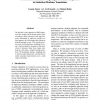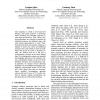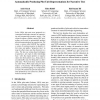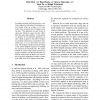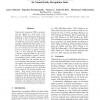104
Voted
EMNLP
2010
14 years 11 months ago
2010
We describe a new approach to SMT adaptation that weights out-of-domain phrase pairs according to their relevance to the target domain, determined by both how similar to it they a...
91
Voted
EMNLP
2010
14 years 11 months ago
2010
This paper proposes a unified framework for zero anaphora resolution, which can be divided into three sub-tasks: zero anaphor detection, anaphoricity determination and antecedent ...
106
Voted
EMNLP
2010
14 years 11 months ago
2010
Confidence-Weighted linear classifiers (CW) and its successors were shown to perform well on binary and multiclass NLP problems. In this paper we extend the CW approach for sequen...
103
click to vote
EMNLP
2010
14 years 11 months ago
2010
Seed sampling is critical in semi-supervised learning. This paper proposes a clusteringbased stratified seed sampling approach to semi-supervised learning. First, various clusteri...
93
Voted
EMNLP
2010
14 years 11 months ago
2010
In the 1980s, plot units were proposed as a conceptual knowledge structure for representing and summarizing narrative stories. Our research explores whether current NLP technology...
118
Voted
EMNLP
2010
14 years 11 months ago
2010
We introduce a novel training algorithm for unsupervised grammar induction, called Zoomed Learning. Given a training set T and a test set S, the goal of our algorithm is to identi...
105
click to vote
EMNLP
2010
14 years 11 months ago
2010
In modern machine translation practice, a statistical phrasal or hierarchical translation system usually relies on a huge set of translation rules extracted from bi-lingual traini...
107
Voted
EMNLP
2010
14 years 11 months ago
2010
Named-entity recognition (NER) is an important task required in a wide variety of applications. While rule-based systems are appealing due to their well-known "explainability...
110
Voted
EMNLP
2010
14 years 11 months ago
2010
Existing graph-based ranking methods for keyphrase extraction compute a single importance score for each word via a single random walk. Motivated by the fact that both documents a...
90
Voted
EMNLP
2010
14 years 11 months ago
2010
We introduce tiered clustering, a mixture model capable of accounting for varying degrees of shared (context-independent) feature structure, and demonstrate its applicability to i...
